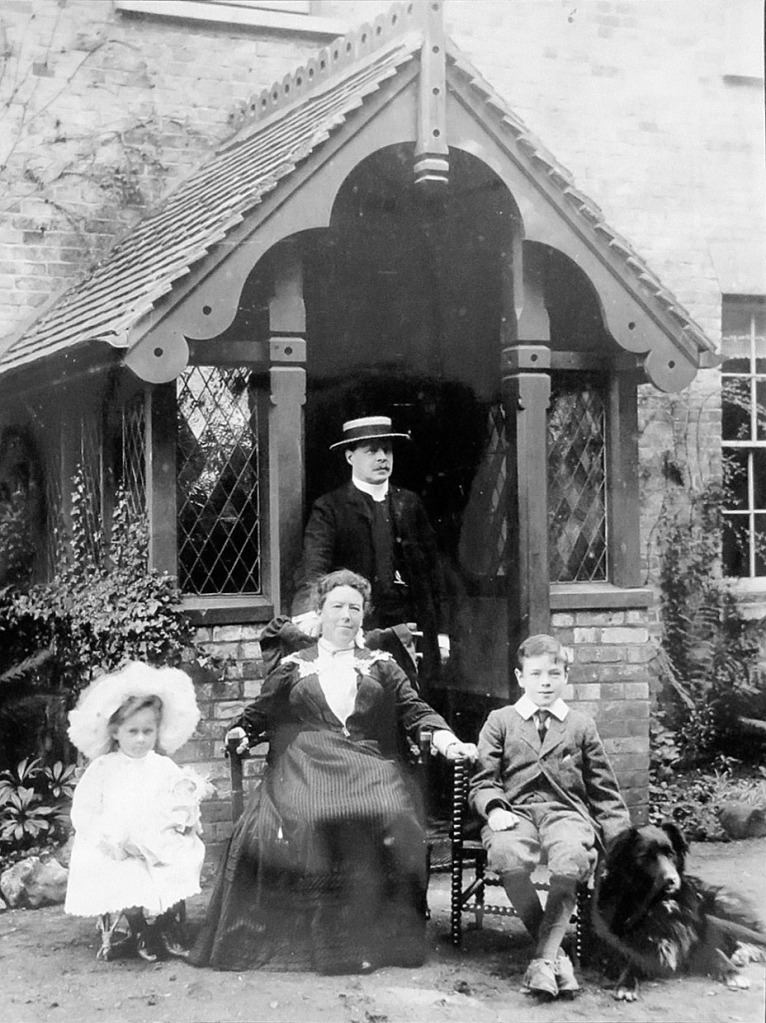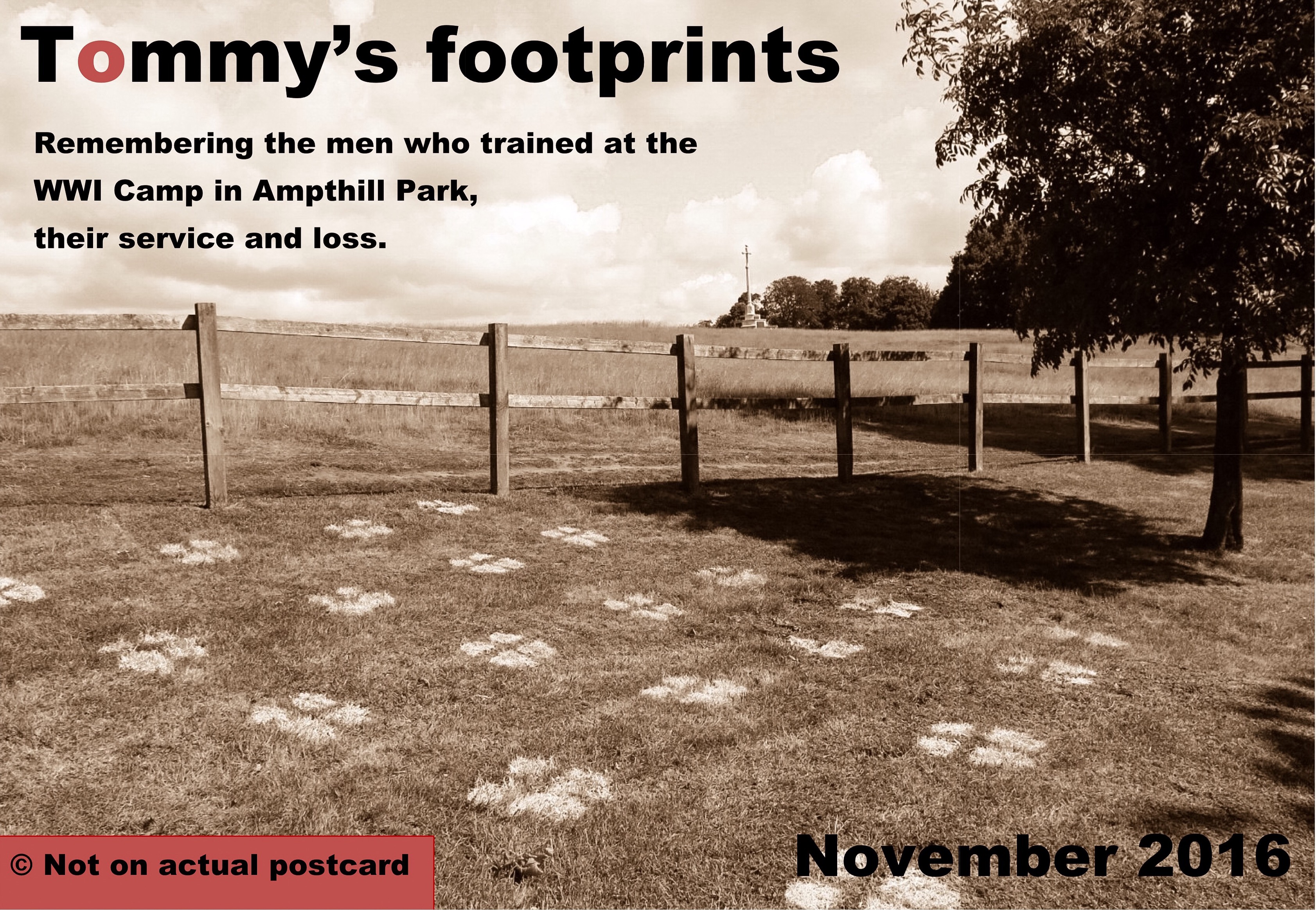Steppingley is a small, quiet village surrounded by farmland which is part of the Duke of Bedford’ Woburn Estate. In 1914 the Duke established the Bedfordshire Training Depot in nearby Ampthill Park. Steppingley boys heeded the call and were among the first enlist.
Six men are named on the brass WWI Memorial Plaque in St.Lawrence’s Church, Steppingley. Four of these trained at the Ampthill Camp. Most of the boys lived in the Duke’s Cottages along Rectory Road.

On November 9, 1914 Thomas Rogers (Rabbit Warrener) and John Battams (Stockman) enlisted together with John’s younger brother, Walter Battams (Farm Labourer). They were given consecutive service numbers.
17710 Private John William Battams
17711 Private Walter Battams
17712 Private Thomas Rogers
Harry Gibbons (Farm Labourer) enlisted the very next day and was assigned 17743.
The four Steppingley boys would have known each other well. They joined the Ampthill Camp when it first opened and would have used the Warren Woods entrenching ground. In June 1915 the soldiers were drafted to the Front.
Arthur Norris (Railway Porter) joined in January 1916 and was assigned the service number 27675. The 1911 Census shows Arthur residing in Lower Stondon where he had gone for work.
The boys served with the Bedfords’. However, little is known of the specifics because 30 years later many of the British Army service records were destroyed in the Blitz.
17710 Private John William Battams
John Battams trained with No.1 Company at the Ampthill Camp. We know that Private John Battams saw action on September 25, 1915 with the 2nd Bedfords’ at the Battle of Loos. This was the first time that the British Artillery used gas. Sadly, on the first day of battle John (22) was killed by a shell during the British attack on Hulluch. In November 1915 the Battams family attended a memorial at St.Lawrence’s Church. The flag flew at half-mast. John is remembered in Steppingley Church and on the Loos Memorial.
This slideshow requires JavaScript.
17711 Private Walter Battams
Walter Battams trained with No.1 Company at the Ampthill Camp. Following training was posted to 2nd Battalion Bedfordshire Regiment.
Walter was injured at least twice and gassed. On June 14, 1916 Walter sustained an injury to the tissue of left hand and was admitted to 1st Service Hospital Rouen – discharged to base depot at Harfleur on June 28, 1916. In May 1918 he was gassed and then on August 7th Walter was shot in the neck.
Walter’s conduct record shows that he was a gallant fellow who was brought to notice on a number occasions. On June 7, 1917 Walter was awarded the Military Medal his brave actions during the taking of Messines Ridge, and in August 1918 was awarded a Bar to the Military Medal. To place Walter’s actions in context only seven of 707 men named on the Duke of Bedford War Memorial were decorated with the Military Medal.
Thankfully, Walter survived the Great War and was demobilized in April 1919, returning to Steppingley. In September 1921 he married Kate Oliver. Kate (52) died in 1950 and is buried in St.Lawrence’s graveyard. In 1983 Walter (88) was buried alongside.
This slideshow requires JavaScript.
17712 Lance Corporal Thomas Rogers
Thomas Rogers was raised to Lance Corporal on February 9, 1915. Posted on June, 22 1915 with the Bedfords’ 2nd Battalion. In Autumn 1915 Thomas was wounded – an ugly gunshot wound to the neck. On July 11, 1916 Thomas saw action with the Bedfords’ at Trone Wood in the Somme region. The wood become the scene of a violent and costly struggle. The war diary reports ‘unexpectedly encountering a trench complex and machine guns.’
Captain Frank Sloan MC, one of the training staff at the Ampthill Training Depot, was also posted to the 2nd Battalion Bedfordshire Regiment. He was present at the battle for Trones Wood and later wrote to the Duke of Bedford describing aspects of the battle.
‘We had a terrific struggle in the Bois de Trones. I saw no mention of it in the papers. One reads glowing accounts of the 7th Royal West Kents in the wood. Our battalion reached the north end of the wood three days before at a time when there wasn’t a British position or a British soldier in the wood. 1100yds long our battalion attacked the wood alone on the morning of the 10th in four waves and we held it until we were relieved 48 hours after. We suffered heavily, 376 men and 5 officers. We were the first to get to a 9.2 howitzer gun in the north of the wood and the name of the regiment is carved on it, we may get it for the town.”
As published by Woburn Abbey (February 2014)
Sixteen Ampthill recruits who were killed that day – more. Thomas (34) was one of the casualties. He left a wife, Fanny, and three young children, Mabel, Horace and Ruby. After Thomas was killed the family wore black for 6 weeks to mourn his death. Thomas is buried in the Dive Copse Cemetery and remembered in Steppingley Church.
This slideshow requires JavaScript.
Photographs used with kind permission of A.T. Rogers (Grandson)
25675 Serjeant Arthur Frederick Owen Norris
In 1914 Arthur Norris was living away in Lower Stondon. On January 26, 1916 Arthur joined the Ampthill Camp and was posted to No.3 Company. On completion of training he was drafted to join the 4th Battalion Bedfordshire Regiment. We know that in April 1917 Arthur sustained gun shot wounds to the left leg and was admitted to hospital in St Omer. Arthur recovered and was returned to active service.
Serjeant Arthur Norris (23) served with in the 4th Bedfords’ at the Second Battle of Ypres and on October 30, 1917 was killed in action. Arthur made Battlefield Will leaving his money in the Post Office Savings Bank and all of his possessions to his mother, Kate Norris, of Flitwick Lodge. Arthur is remembered on the Tyne Cot Memorial, in St.Lawrence’s Church and on the Flitwick War Memorial.

Flitwick War Memorial
17743 Corporal Harry Gibbons
We know that Private 76192 Harry Gibbons was with the Middlesex Regiment before he joined the Bedfords’. Harry was given a new service number, 17743, and was at the Training Depot for nearly seven months, assigned to No.1 Company. On June 9, 1915 he was posted to the 2nd Battalion Bedfordshire Regiment in France. Whilst with this Battalion he was admitted to hospital twice. The first time Harry was suffering with bronchitis. On September 3, 1916 he then received a gunshot wound to the back.
On his return from hospital in Bologne Harry transferred to the 4th Battalion. Harry went into battle at Moeuvres, France, during the Hundred Day Offensive in 1918. On September 27th the Allied Forces advanced towards the Hindenburg support Line – the last major defensive position taken up by the German Army in the war. In capturing their objective Corporal Harry Gibbons (23) was killed. He is buried at Moeuvres Cemetery – more.
Two other Steppingley boys are named on the memorial plate in St.Lawrence’s Church.
G/60786 Private Herbert Brightman
Herbert Brightman lived at No. 57 Duke’s Cottages, Steppingley. His trade was a Hatblocker. Herbert attested on May 11, 1916 and joined the Royal Fusiliers (London Regiment). We know that a H.Brightman trained at the Ampthill Camp but this is a different soldier – 23316 Private Herbert Brightman – who came from Dunstable.
Private Herbert Brightman (29) was killed in action on March 28, 1918. Herbert is buried in the Mesnil Communal Cemetry, France.
____________________________
242223 Private Hector Stanley Warner
Stanley Warner lived at No.31 Duke’s Cottages, Steppingley. He was a farm labourer. Hector attested on September 27, 1916 and joined the Sherwood Foresters (Nottingham & Derby) Regiment. We know that Hector served with the 24th Battalion.
Private Hector Warner (20) was killed in action on October, 17 1918 just three weeks before the Armistice. Hector is buried in the Busigny Communal Cemetry, France.

Sources:
The Bedfordshire Standard. The original broadsheet is part of the Bedfordshire & Luton Archive.
Commonwealth War Graves Commission
RBL Roll of Honour
Bedsatwar blog
Bedsathome blog
Bedfordshire Regiment
Flitwick: A story of Two World Wars (Phillip Thompson, 2014)
Thank you to Angela & Terry Hughes, Tony & Joan Rogers, Ian Church, Steve Fuller and Nicola Evans.
©S.Hartley (2016-)
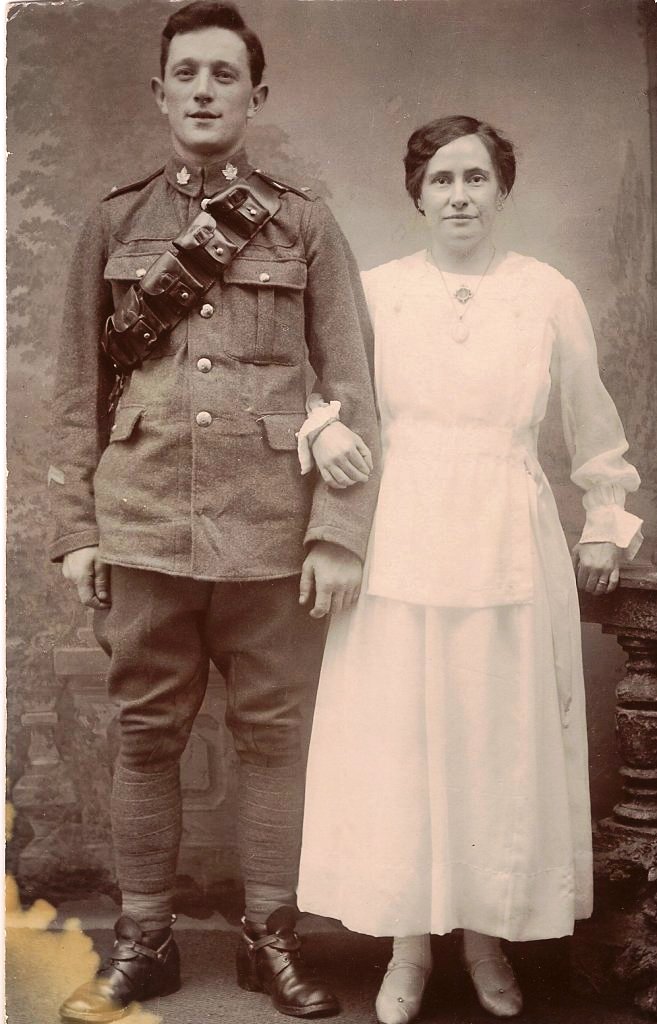 Summer 1918 – the 126th Company moved its operation from Ampthill to Thetford Forest.
On 25th October 1918 Private Dimock was admitted to Thetford Military Hospital. The medical record states
Summer 1918 – the 126th Company moved its operation from Ampthill to Thetford Forest.
On 25th October 1918 Private Dimock was admitted to Thetford Military Hospital. The medical record states
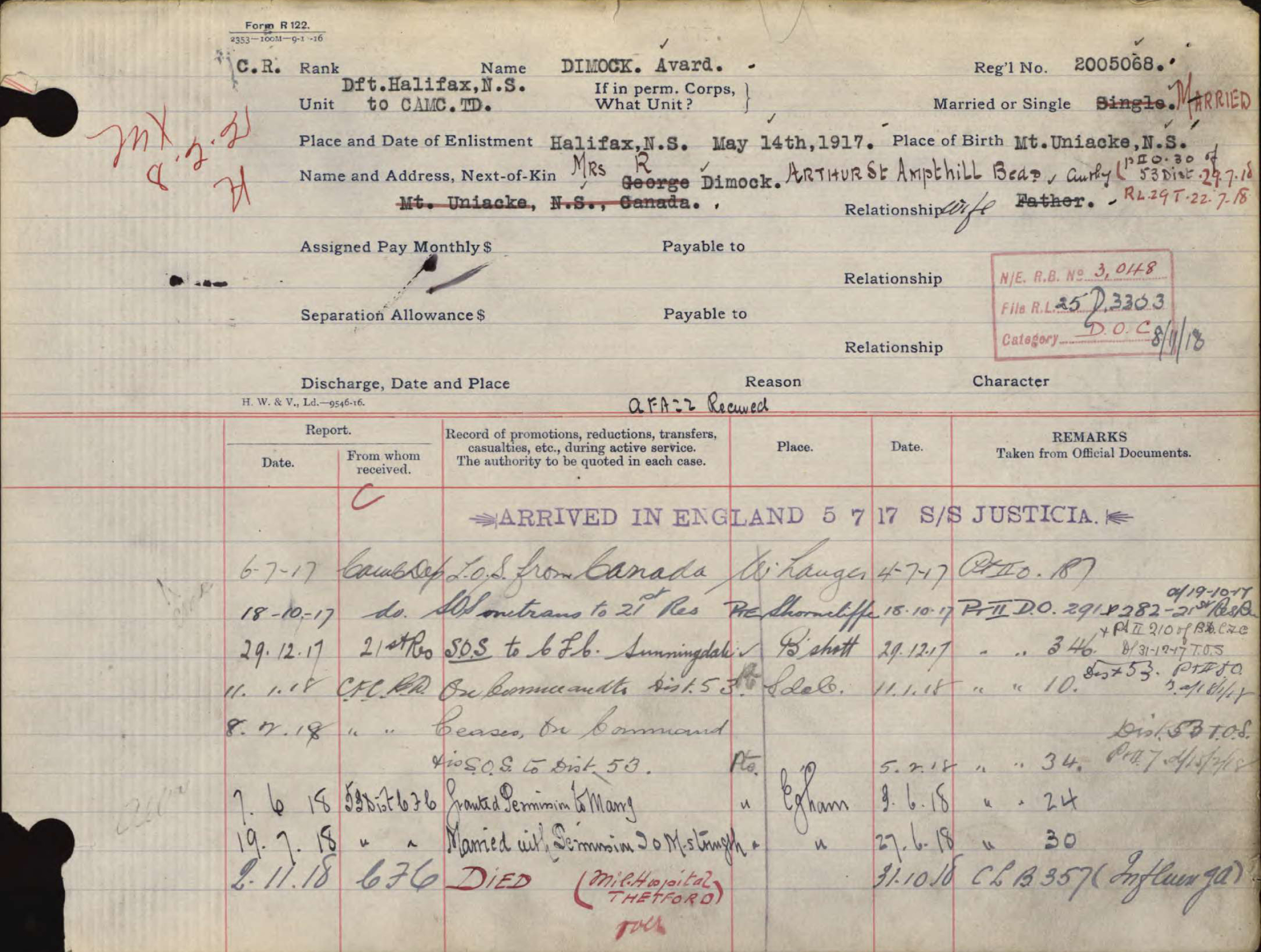 The body of 2005068 Private Avard L. DIMOCK (*21yrs) was brought back to Ampthill for burial at St. Andrew’s Church on 4th November 1918, where he rests. The gravestone – a stone cross – was made by Thomas Wildman of Church Street, Ampthill and is signed.
*Avard’s year of birth is recorded as 1897 and 1898. Age appears as 24yrs on the headstone
Avard’s Will of 14th May 1917 bequeathed his personal estate to his father, George Dimock. Mrs Rose Ellen Dimock received a widow’s war gratuity of $180.
Records show that in 1922 Rose Ellen Dimock and Avard’s mother, Mrs Jennie Dimock (1866-1948), were each issued with the Memorial Cross – a sterling silver Greek cross (engraved) on a purple ribbon for wearing around the neck. As the next-of-kin, Rose Ellen also received the phosphor bronze memorial plaque and the scroll.
Avard Dimock is remembered on The Alameda Cenotaph and on a memorial in Ampthill Methodist Church – a large brass plate Inside the Nave on the East wall. The Memorial Plate is inlaid with enamel and measures about a yard square. It was unveiled on 5, December 1920 and restored in 2019
Rose Ellen Dimock (1886-1969) stayed in Ampthill. The 1939 Register records her as living at 23, Arthur Street. Rose did not re-marry.
Headstone – repair and rededication
Over the years the gravestone weathered and sustained damage.
The body of 2005068 Private Avard L. DIMOCK (*21yrs) was brought back to Ampthill for burial at St. Andrew’s Church on 4th November 1918, where he rests. The gravestone – a stone cross – was made by Thomas Wildman of Church Street, Ampthill and is signed.
*Avard’s year of birth is recorded as 1897 and 1898. Age appears as 24yrs on the headstone
Avard’s Will of 14th May 1917 bequeathed his personal estate to his father, George Dimock. Mrs Rose Ellen Dimock received a widow’s war gratuity of $180.
Records show that in 1922 Rose Ellen Dimock and Avard’s mother, Mrs Jennie Dimock (1866-1948), were each issued with the Memorial Cross – a sterling silver Greek cross (engraved) on a purple ribbon for wearing around the neck. As the next-of-kin, Rose Ellen also received the phosphor bronze memorial plaque and the scroll.
Avard Dimock is remembered on The Alameda Cenotaph and on a memorial in Ampthill Methodist Church – a large brass plate Inside the Nave on the East wall. The Memorial Plate is inlaid with enamel and measures about a yard square. It was unveiled on 5, December 1920 and restored in 2019
Rose Ellen Dimock (1886-1969) stayed in Ampthill. The 1939 Register records her as living at 23, Arthur Street. Rose did not re-marry.
Headstone – repair and rededication
Over the years the gravestone weathered and sustained damage.
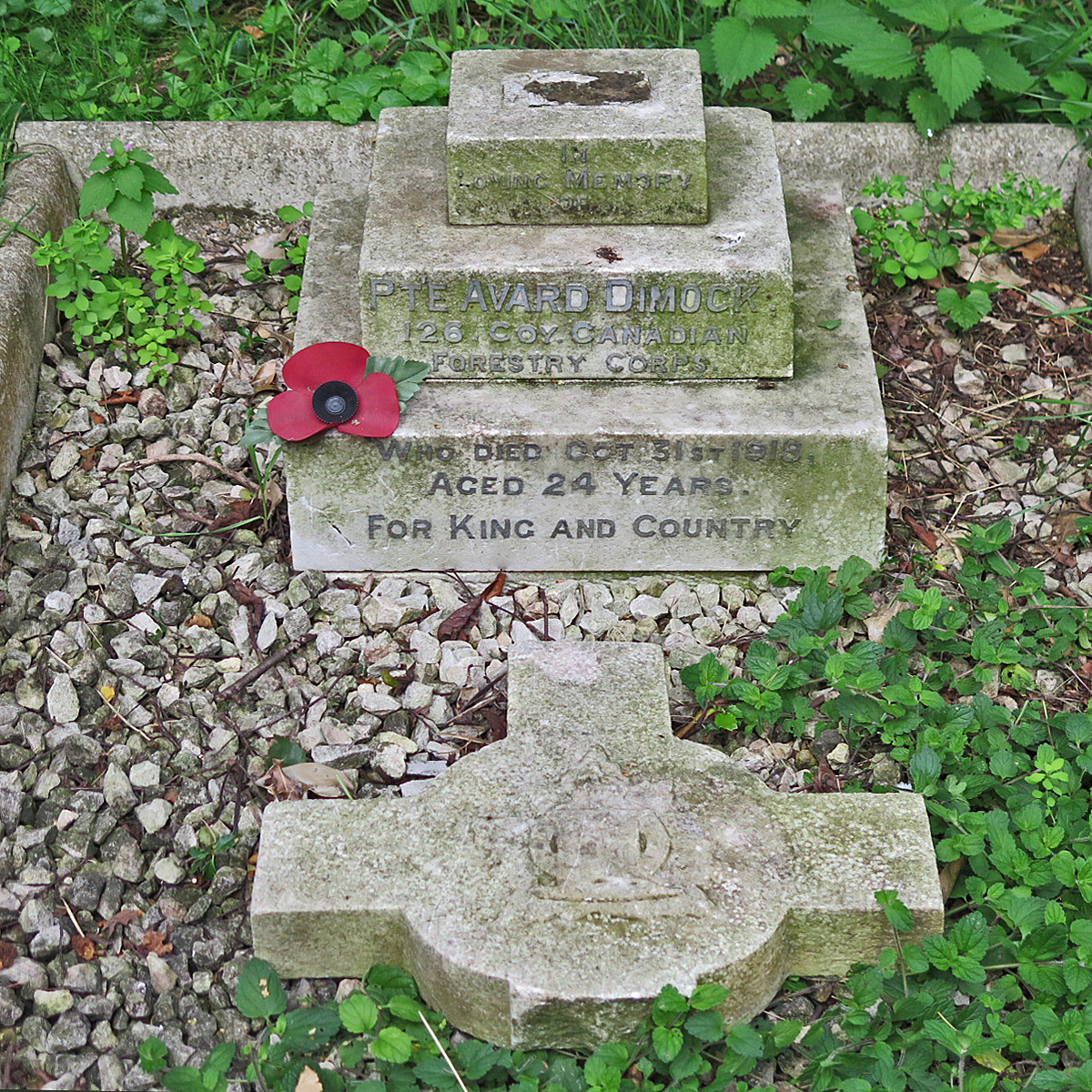 In 2017, as part of the WWI Centenary, Cllr Simon Peacock (Ampthill Mayor) championed repairing the headstone, which Neville Funeral Service generously undertook as a community contribution. The headstone was lifted and restored in time for Remembrance Sunday 2017 when a representative of the Canadian High Commission attended for a service of rededication.
In 2017, as part of the WWI Centenary, Cllr Simon Peacock (Ampthill Mayor) championed repairing the headstone, which Neville Funeral Service generously undertook as a community contribution. The headstone was lifted and restored in time for Remembrance Sunday 2017 when a representative of the Canadian High Commission attended for a service of rededication.
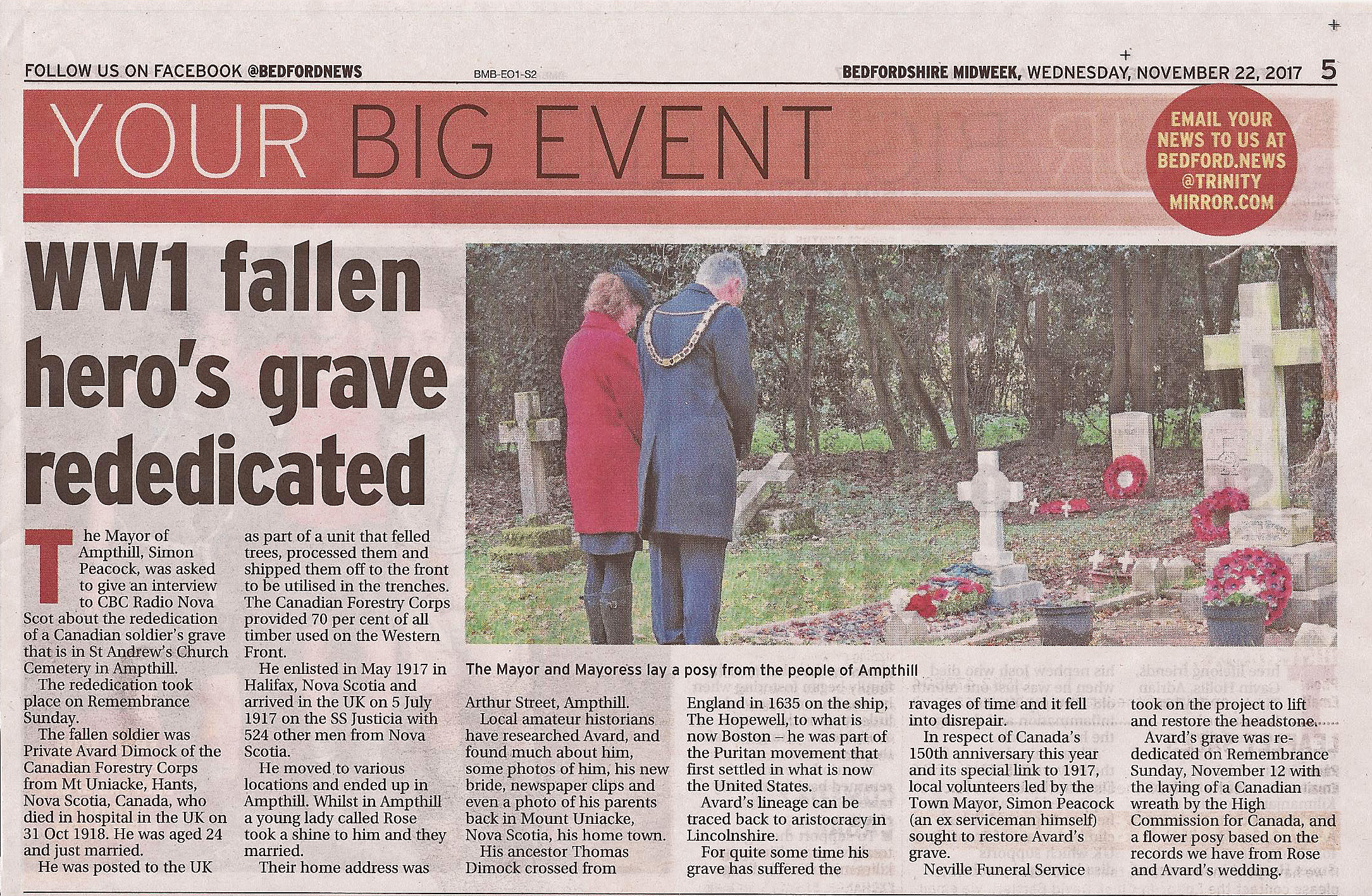 Source:
The Bedfordshire Standard; Bedfordshire Times. The original broadsheet is part of the Bedfordshire & Luton Archive.
Ampthill Parish Magazine
Commonwealth War Graves Commission
RBL Roll of Honour
Ancestry.com
The National Archives
Library and Archives Canada
British Newspaper Archive
Ampthill’s Fallen – by John Hele (2014)
Www.bedfordshireregiment.co.uk
#IWMSTORIES
Text and images copyright S.Hartley (2015-)
Source:
The Bedfordshire Standard; Bedfordshire Times. The original broadsheet is part of the Bedfordshire & Luton Archive.
Ampthill Parish Magazine
Commonwealth War Graves Commission
RBL Roll of Honour
Ancestry.com
The National Archives
Library and Archives Canada
British Newspaper Archive
Ampthill’s Fallen – by John Hele (2014)
Www.bedfordshireregiment.co.uk
#IWMSTORIES
Text and images copyright S.Hartley (2015-) 















